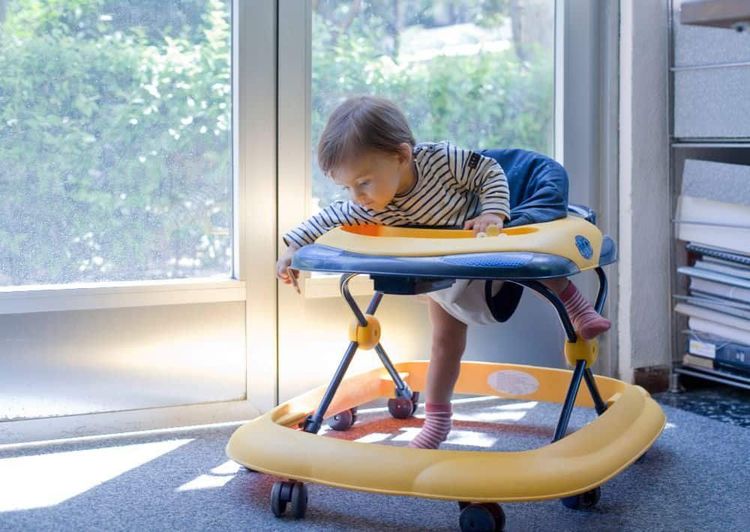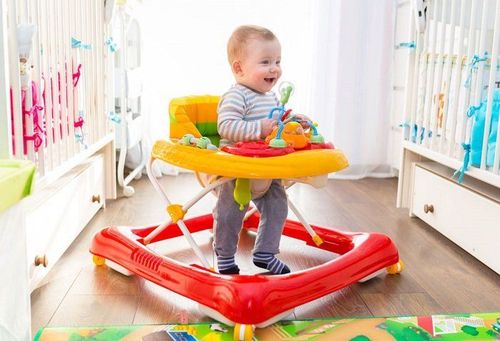This is an automatically translated article.
Should children use a walker? It is a concern of many parents who have young children in the stage of learning to walk. Accordingly, the American Academy of Pediatrics recommends that parents do not use baby walkers because it can cause many risks. So is it really advisable to let children ride a walker? Please refer to the article below for useful information!
1. How do children learn to walk?
Most infants pass the following milestones before walking on their own:
Rolling on the floor Sitting Crawling, climbing, or clinging to objects to stand up Moves around stationary objects Babies need a lot of time to learn and practice these activities in order to be able to walk.
2. Should children use a walker?
Some parents believe that walkers are useful for babies both to help them learn to walk and have fun. However, this is not the right thing to do because this device can be dangerous and slow down your child's development.
Starting from 6 months old, babies love to stand up straight and love to move so they can explore and master things. However, parents can use other devices that are both safe and upright, such as a stationary stand.
Many parents buy this device because they think the walker helps their baby learn to walk faster. However, the opposite is true. The walker does not help the baby develop the ability to walk, but interferes or delays the development and achievement of important motor milestones. The more time the baby sits in the walker, the more retarded in development.
A walker can give caregivers a false sense of security and make them think they don't need to watch the baby too much. Therefore, parents are recommended to say no to baby walkers.
In fact, a walker can slow down your baby's motor (walking) development. Because your baby will miss out on practicing the important repetitive movements needed before learning to walk. Newborns tend to use their toes when in a walker, which strains the leg muscles and interferes with normal walking development. Once out of the walker frame, they often want to continue using their toes in the same way, and that's not how babies can walk.
When babies sit and pull themselves up, they are learning to balance. Babies don't know how to balance in a walker, slowing down learning this important skill. Using a walker also means spending less time on hands and knees in a crawling or crawling position. This type of movement is important for developing the weight-bearing capacity of both the pelvis and shoulders.
In addition, many other important movements are needed when a child is developing walking skills, but children have less opportunity to practice these movements in a walker than when learning to walk directly on the floor.

Giải đáp có nên cho trẻ dùng xe tập đi không?
3. Dangers of walkers
Walkers are not recommended in Australia and they are banned in Canada. These devices are considered unsafe because they move very quickly. Your baby is also taller when standing upright in a walker and can reach things they normally can't reach.
According to a study in the journal Pediatrics, between 1990 and 2014, more than 230,000 children under 15 months of age were treated in US emergency departments for walker-related injuries. In 2014, 2,000 toddlers even ended up in emergency rooms with walker injuries. Most injuries occur when children fall down stairs in a walker, often to the head or neck, which can sometimes be life-threatening.
Potential hazards that a walker can pose include:
Falling down stairs Crashing something sharp or hard Overturning while moving Overturned by another older child Muscle gain access to electrical cords or cupboards with hazardous chemicals Move quickly to hazardous areas such as fireplaces, ovens or swimming pools Can reach hot drinks on tables or other dangerous objects Each In Australia, many babies are injured when using a walker every year. In some cases, serious injuries were caused by burns, cuts, head injuries, broken bones, poisoning and drowning; some even died.

Luôn ở gần trẻ khi bé dùng xe tập đi
4. Safety instructions for baby using a walker
Although the risks outweigh the benefits of a walker, parents who have decided to purchase this device should keep a few things in mind:
Make sure that the walker is comply with consumer product safety standards. Stay close to your children and be aware that they can move to dangerous places in as short as a few seconds. Make sure that the walker can only be used on a flat surface, with no access to steps or stairs. Use only in protected areas that are safe for children. This means keeping the walker away from dangerous objects such as electrical cords, hot drinks, cleaning chemicals, stoves, fireplaces, swimming pools or toilets. Choose a walker that has a lock to prevent it from moving when you want it to, and has a brake mechanism. Do not use the walker before your baby learns to sit or after he has learned to walk. Do not leave your baby in the walker for longer than 15 minutes. Note: Criteria for rating safety walkers
With brakes to help prevent falling down stairs Has leaflets with specific information on safety instructions Always keep babies within sight Use only walker on a flat surface, free of overturning obstacles, and away from all flammable objects Finally, parents can create conditions to support their child's safe walking, such as: space on the floor; Place your baby near soft furniture to help him hold onto and stand up on his own; Limit a safe area where your baby can play and move.
Please dial HOTLINE for more information or register for an appointment HERE. Download MyVinmec app to make appointments faster and to manage your bookings easily.













